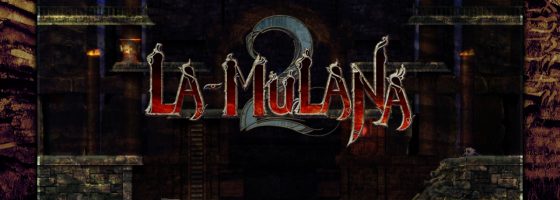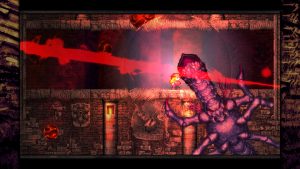La-Mulana is one of the trickiest series to review thanks to its combination of high skill gameplay and just plain frustrating design. The last time I played it, I could not recommend it for its focus on difficult for the sake of difficult design. I also received all manner of threats and attacks from fans saying that I didn’t like hard games. With La-Mulana 2, the developers are back with another grueling run through the temple. And if you’re hoping that they have improved things…no such luck.
Spelunking:
The story of La-Mulana 2 kicks off several years after the end of the first game. You now play the daughter of the hero of La-Mulana. When monsters start appearing in the ruins, she decides to investigate.
La-Mulana’s gameplay loop is built on an even mix of metroidvania and heavy puzzle solving. Every area in the game is full of secrets, treasures, and all manner of death traps. The game prides itself on giving the player a grand mystery to uncover.
The game demands exploration to find clues needed to open up the various treasure chests and doors in the temple. You will have to make frequent use of save points, as the threat of an instant kill is always around the corner.
Part of the allure of the series is that this is not a quick game to play. You can expect to spend a long time combing over every inch of the areas. This is a game that’s all too happy to have false walls that lead to brand new areas.
Major progress is defined by defeating the guardians — massive bosses that always require multiple steps to find and access. La-Mulana 2’s gameplay presents the best and worst parts of its design, and we’ll start with the good.
Master Metroidvania:
From a metroidvania standpoint, the La-Mulana franchise is an amazing example of this kind of design. There are dozens of items for you to find throughout La-Mulana 2; each one giving you something new to do or a place to access.
How each new item becomes integrated into your routine is the best part of La-Mulana 2, and you really do change how you play the game as you go through it. This is where the achievement of unlocking a new chest comes in, as you never know what upgrade you’re going to find next.
One of the most polarizing aspects of La-Mulana 2, and what we’ll talk more about in the next section, has to do with the level flow and pacing of the game. As anyone who has played a metroidvania knows, a key part of the progression is finding something that you can’t access yet and coming back to it later.
With La-Mulana 2, the game quickly opens up with multiple areas to go through. Unlike other metroidvanias where there is an established order to go through and power up, La-Mulana 2 doesn’t do that.
It is possible to make progress in an area while missing a chain that you’re supposed to do to unlock something in another area. Eventually you’re going to do it all, but the order for each player will differ based on what items they find first.
This is compounded by the puzzle design, and why La-Mulana 2 features some of the worst designed puzzles that create frustration.
Missing Pieces:
Good puzzle design in any video game is about educating the player as to what the intended goal is and giving them the breadcrumbs needed to solve it. With that said the major point of contention for La-Mulana as a series is with their puzzle design.
This is a game that is all too happy to have a puzzle, but not give the player any idea what the solution could be, or even if it’s possible to solve it now. To make matters worse, the game has a nasty habit of putting clues to puzzles nowhere near said puzzle.
Several times I would find a puzzle in one area, find a clue to solve it another area, and then find the actual item I needed in yet a third area of the game.
Every example of frustrating puzzle design seen in the adventure genre is on display in La-Mulana 2. From esoteric solutions, to event triggers that must be tripped in order to move a puzzle forward, but no idea what those triggers are. Anyone who says that they beat this game on their first play in a reasonable time without any outside help or guides is lying.
The frustration is compounded by the lack of any sense of pacing or structure within the game space. Expect to back track, re-track, and back track some more, as you try to move forward in inches throughout each area.
Due to the non-linear nature, it’s even hard to look up tips based on where you’re at, as you could be missing an essential item that you didn’t know about.
The problem is that the game breaks the unwritten contract between designer and player. As a designer, it’s your job to educate the player on the rules of your own gamespace. In this game, half the problem with the puzzles is that the player doesn’t know how the world works. It’s one thing not to be sure of a puzzle solution; it’s another thing entirely to not even know the existence of the solution.
A Failure to Communicate:
The final straw for La-Mulana 2 came when I was hopelessly stuck without any new areas to explore. I had a friend feeding me tips and I had an idea of what I needed to do, but not how to do it. He then revealed to me the solution, and it was something I would have never found on my own, and neither of us could find any in-game hints that would have led to the solution organically.
If I can’t trust the game to at least point me in the right direction, then I’m not going to waste time playing it. And that right there is why La-Mulana 2 is just stubborn in its ways. It wouldn’t take that much to open the game up to more people without hurting the challenge. Even just a simple sound cue to let the player know if a puzzle is solvable at the current time would go a long way towards inviting more people to play it.
I’m sure there are people who are going to leave comments below about how easy they found the game and etc, etc, but I can’t recommend a game like this when there are far more approachable metroidvanias out there.
In the end, La-Mulana 2 has all the depth, but none of the accessibility of the metroidvania genre, and you will either love it or hate it for that.





